PepsiCo: Total Quality Management Benchmarking at Pepsi Cola
VerifiedAdded on 2022/01/22
|22
|7753
|666
Report
AI Summary
This report provides an overview of PepsiCo, Inc., and its soft drink division, Pepsi-Cola Company, with a focus on Total Quality Management (TQM) and benchmarking practices. It traces PepsiCo's history from its origins to its current status, including the mergers and acquisitions that have shaped the company. The report highlights Pepsi's competitive strategies, particularly in Pakistan, where Shamim & Co. operates as a major franchisee. It analyzes Shamim & Co.'s operations, production, and quality control measures, emphasizing its competitive priorities of high-performance design and consistent quality. The report also examines PepsiCo's global strategy and market dominance in the beverage and snack food industries, offering insights into its approach to quality management and its success in various markets.
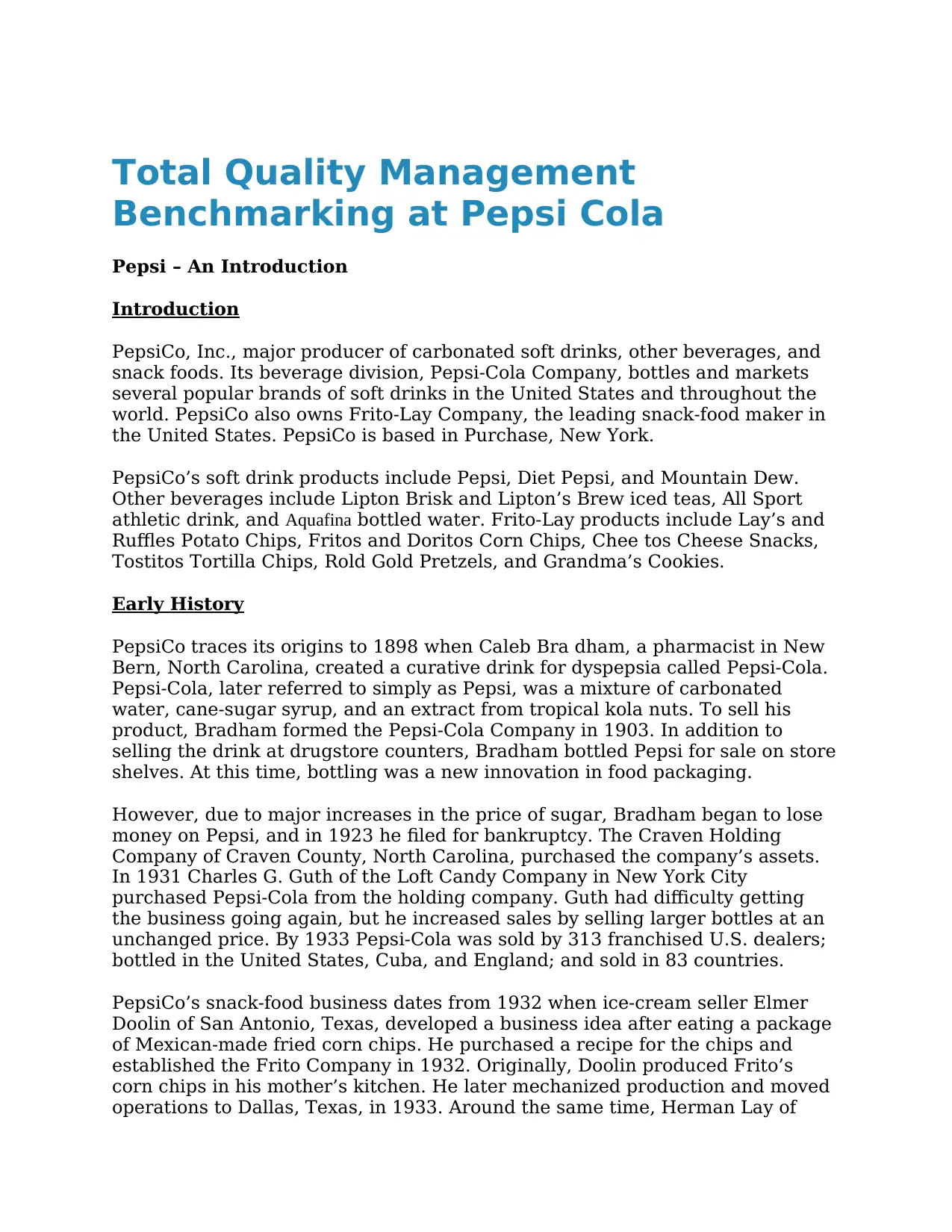
Total Quality Management
Benchmarking at Pepsi Cola
Pepsi – An Introduction
Introduction
PepsiCo, Inc., major producer of carbonated soft drinks, other beverages, and
snack foods. Its beverage division, Pepsi-Cola Company, bottles and markets
several popular brands of soft drinks in the United States and throughout the
world. PepsiCo also owns Frito-Lay Company, the leading snack-food maker in
the United States. PepsiCo is based in Purchase, New York.
PepsiCo’s soft drink products include Pepsi, Diet Pepsi, and Mountain Dew.
Other beverages include Lipton Brisk and Lipton’s Brew iced teas, All Sport
athletic drink, and Aquafina bottled water. Frito-Lay products include Lay’s and
Ruffles Potato Chips, Fritos and Doritos Corn Chips, Chee tos Cheese Snacks,
Tostitos Tortilla Chips, Rold Gold Pretzels, and Grandma’s Cookies.
Early History
PepsiCo traces its origins to 1898 when Caleb Bra dham, a pharmacist in New
Bern, North Carolina, created a curative drink for dyspepsia called Pepsi-Cola.
Pepsi-Cola, later referred to simply as Pepsi, was a mixture of carbonated
water, cane-sugar syrup, and an extract from tropical kola nuts. To sell his
product, Bradham formed the Pepsi-Cola Company in 1903. In addition to
selling the drink at drugstore counters, Bradham bottled Pepsi for sale on store
shelves. At this time, bottling was a new innovation in food packaging.
However, due to major increases in the price of sugar, Bradham began to lose
money on Pepsi, and in 1923 he filed for bankruptcy. The Craven Holding
Company of Craven County, North Carolina, purchased the company’s assets.
In 1931 Charles G. Guth of the Loft Candy Company in New York City
purchased Pepsi-Cola from the holding company. Guth had difficulty getting
the business going again, but he increased sales by selling larger bottles at an
unchanged price. By 1933 Pepsi-Cola was sold by 313 franchised U.S. dealers;
bottled in the United States, Cuba, and England; and sold in 83 countries.
PepsiCo’s snack-food business dates from 1932 when ice-cream seller Elmer
Doolin of San Antonio, Texas, developed a business idea after eating a package
of Mexican-made fried corn chips. He purchased a recipe for the chips and
established the Frito Company in 1932. Originally, Doolin produced Frito’s
corn chips in his mother’s kitchen. He later mechanized production and moved
operations to Dallas, Texas, in 1933. Around the same time, Herman Lay of
Benchmarking at Pepsi Cola
Pepsi – An Introduction
Introduction
PepsiCo, Inc., major producer of carbonated soft drinks, other beverages, and
snack foods. Its beverage division, Pepsi-Cola Company, bottles and markets
several popular brands of soft drinks in the United States and throughout the
world. PepsiCo also owns Frito-Lay Company, the leading snack-food maker in
the United States. PepsiCo is based in Purchase, New York.
PepsiCo’s soft drink products include Pepsi, Diet Pepsi, and Mountain Dew.
Other beverages include Lipton Brisk and Lipton’s Brew iced teas, All Sport
athletic drink, and Aquafina bottled water. Frito-Lay products include Lay’s and
Ruffles Potato Chips, Fritos and Doritos Corn Chips, Chee tos Cheese Snacks,
Tostitos Tortilla Chips, Rold Gold Pretzels, and Grandma’s Cookies.
Early History
PepsiCo traces its origins to 1898 when Caleb Bra dham, a pharmacist in New
Bern, North Carolina, created a curative drink for dyspepsia called Pepsi-Cola.
Pepsi-Cola, later referred to simply as Pepsi, was a mixture of carbonated
water, cane-sugar syrup, and an extract from tropical kola nuts. To sell his
product, Bradham formed the Pepsi-Cola Company in 1903. In addition to
selling the drink at drugstore counters, Bradham bottled Pepsi for sale on store
shelves. At this time, bottling was a new innovation in food packaging.
However, due to major increases in the price of sugar, Bradham began to lose
money on Pepsi, and in 1923 he filed for bankruptcy. The Craven Holding
Company of Craven County, North Carolina, purchased the company’s assets.
In 1931 Charles G. Guth of the Loft Candy Company in New York City
purchased Pepsi-Cola from the holding company. Guth had difficulty getting
the business going again, but he increased sales by selling larger bottles at an
unchanged price. By 1933 Pepsi-Cola was sold by 313 franchised U.S. dealers;
bottled in the United States, Cuba, and England; and sold in 83 countries.
PepsiCo’s snack-food business dates from 1932 when ice-cream seller Elmer
Doolin of San Antonio, Texas, developed a business idea after eating a package
of Mexican-made fried corn chips. He purchased a recipe for the chips and
established the Frito Company in 1932. Originally, Doolin produced Frito’s
corn chips in his mother’s kitchen. He later mechanized production and moved
operations to Dallas, Texas, in 1933. Around the same time, Herman Lay of
Paraphrase This Document
Need a fresh take? Get an instant paraphrase of this document with our AI Paraphraser
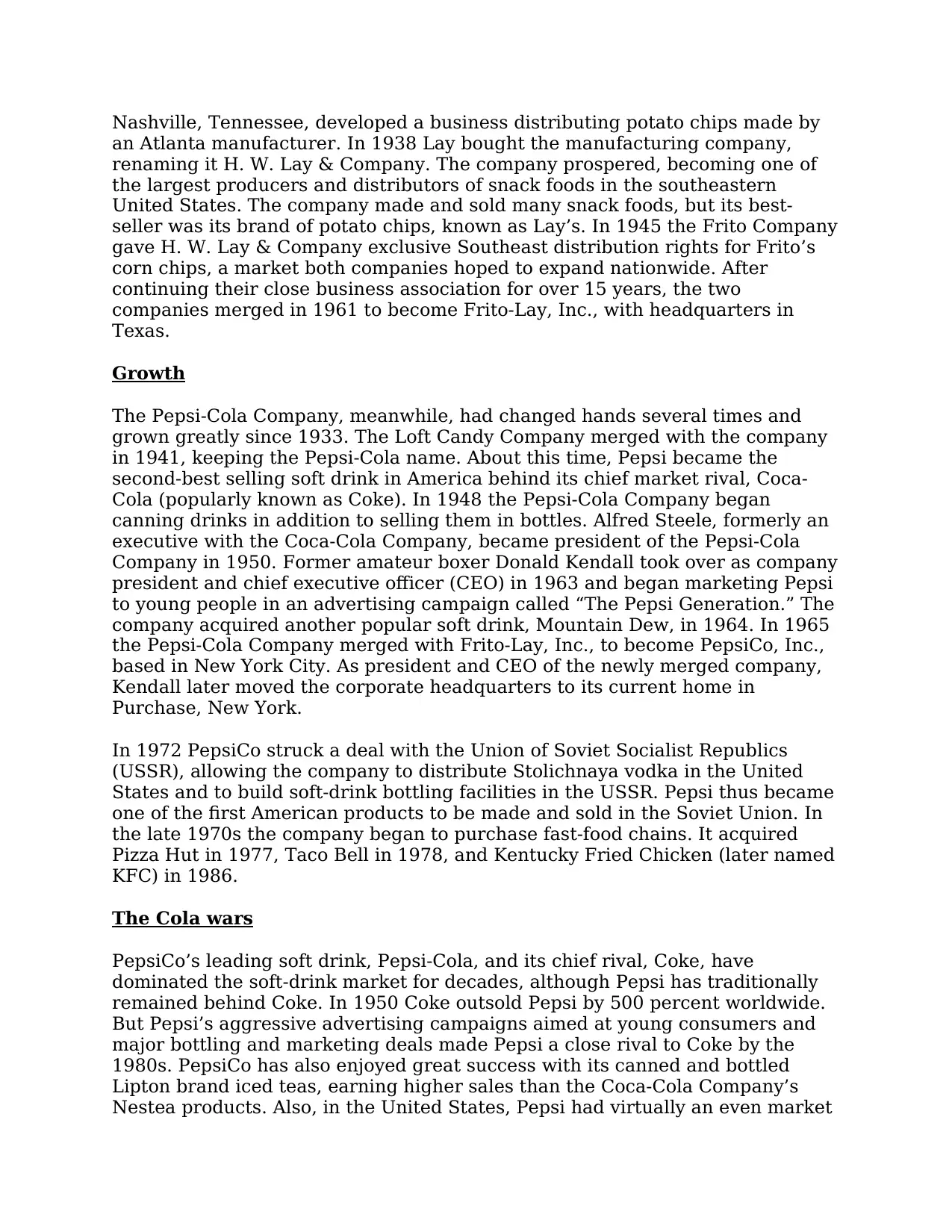
Nashville, Tennessee, developed a business distributing potato chips made by
an Atlanta manufacturer. In 1938 Lay bought the manufacturing company,
renaming it H. W. Lay & Company. The company prospered, becoming one of
the largest producers and distributors of snack foods in the southeastern
United States. The company made and sold many snack foods, but its best-
seller was its brand of potato chips, known as Lay’s. In 1945 the Frito Company
gave H. W. Lay & Company exclusive Southeast distribution rights for Frito’s
corn chips, a market both companies hoped to expand nationwide. After
continuing their close business association for over 15 years, the two
companies merged in 1961 to become Frito-Lay, Inc., with headquarters in
Texas.
Growth
The Pepsi-Cola Company, meanwhile, had changed hands several times and
grown greatly since 1933. The Loft Candy Company merged with the company
in 1941, keeping the Pepsi-Cola name. About this time, Pepsi became the
second-best selling soft drink in America behind its chief market rival, Coca-
Cola (popularly known as Coke). In 1948 the Pepsi-Cola Company began
canning drinks in addition to selling them in bottles. Alfred Steele, formerly an
executive with the Coca-Cola Company, became president of the Pepsi-Cola
Company in 1950. Former amateur boxer Donald Kendall took over as company
president and chief executive officer (CEO) in 1963 and began marketing Pepsi
to young people in an advertising campaign called “The Pepsi Generation.” The
company acquired another popular soft drink, Mountain Dew, in 1964. In 1965
the Pepsi-Cola Company merged with Frito-Lay, Inc., to become PepsiCo, Inc.,
based in New York City. As president and CEO of the newly merged company,
Kendall later moved the corporate headquarters to its current home in
Purchase, New York.
In 1972 PepsiCo struck a deal with the Union of Soviet Socialist Republics
(USSR), allowing the company to distribute Stolichnaya vodka in the United
States and to build soft-drink bottling facilities in the USSR. Pepsi thus became
one of the first American products to be made and sold in the Soviet Union. In
the late 1970s the company began to purchase fast-food chains. It acquired
Pizza Hut in 1977, Taco Bell in 1978, and Kentucky Fried Chicken (later named
KFC) in 1986.
The Cola wars
PepsiCo’s leading soft drink, Pepsi-Cola, and its chief rival, Coke, have
dominated the soft-drink market for decades, although Pepsi has traditionally
remained behind Coke. In 1950 Coke outsold Pepsi by 500 percent worldwide.
But Pepsi’s aggressive advertising campaigns aimed at young consumers and
major bottling and marketing deals made Pepsi a close rival to Coke by the
1980s. PepsiCo has also enjoyed great success with its canned and bottled
Lipton brand iced teas, earning higher sales than the Coca-Cola Company’s
Nestea products. Also, in the United States, Pepsi had virtually an even market
an Atlanta manufacturer. In 1938 Lay bought the manufacturing company,
renaming it H. W. Lay & Company. The company prospered, becoming one of
the largest producers and distributors of snack foods in the southeastern
United States. The company made and sold many snack foods, but its best-
seller was its brand of potato chips, known as Lay’s. In 1945 the Frito Company
gave H. W. Lay & Company exclusive Southeast distribution rights for Frito’s
corn chips, a market both companies hoped to expand nationwide. After
continuing their close business association for over 15 years, the two
companies merged in 1961 to become Frito-Lay, Inc., with headquarters in
Texas.
Growth
The Pepsi-Cola Company, meanwhile, had changed hands several times and
grown greatly since 1933. The Loft Candy Company merged with the company
in 1941, keeping the Pepsi-Cola name. About this time, Pepsi became the
second-best selling soft drink in America behind its chief market rival, Coca-
Cola (popularly known as Coke). In 1948 the Pepsi-Cola Company began
canning drinks in addition to selling them in bottles. Alfred Steele, formerly an
executive with the Coca-Cola Company, became president of the Pepsi-Cola
Company in 1950. Former amateur boxer Donald Kendall took over as company
president and chief executive officer (CEO) in 1963 and began marketing Pepsi
to young people in an advertising campaign called “The Pepsi Generation.” The
company acquired another popular soft drink, Mountain Dew, in 1964. In 1965
the Pepsi-Cola Company merged with Frito-Lay, Inc., to become PepsiCo, Inc.,
based in New York City. As president and CEO of the newly merged company,
Kendall later moved the corporate headquarters to its current home in
Purchase, New York.
In 1972 PepsiCo struck a deal with the Union of Soviet Socialist Republics
(USSR), allowing the company to distribute Stolichnaya vodka in the United
States and to build soft-drink bottling facilities in the USSR. Pepsi thus became
one of the first American products to be made and sold in the Soviet Union. In
the late 1970s the company began to purchase fast-food chains. It acquired
Pizza Hut in 1977, Taco Bell in 1978, and Kentucky Fried Chicken (later named
KFC) in 1986.
The Cola wars
PepsiCo’s leading soft drink, Pepsi-Cola, and its chief rival, Coke, have
dominated the soft-drink market for decades, although Pepsi has traditionally
remained behind Coke. In 1950 Coke outsold Pepsi by 500 percent worldwide.
But Pepsi’s aggressive advertising campaigns aimed at young consumers and
major bottling and marketing deals made Pepsi a close rival to Coke by the
1980s. PepsiCo has also enjoyed great success with its canned and bottled
Lipton brand iced teas, earning higher sales than the Coca-Cola Company’s
Nestea products. Also, in the United States, Pepsi had virtually an even market
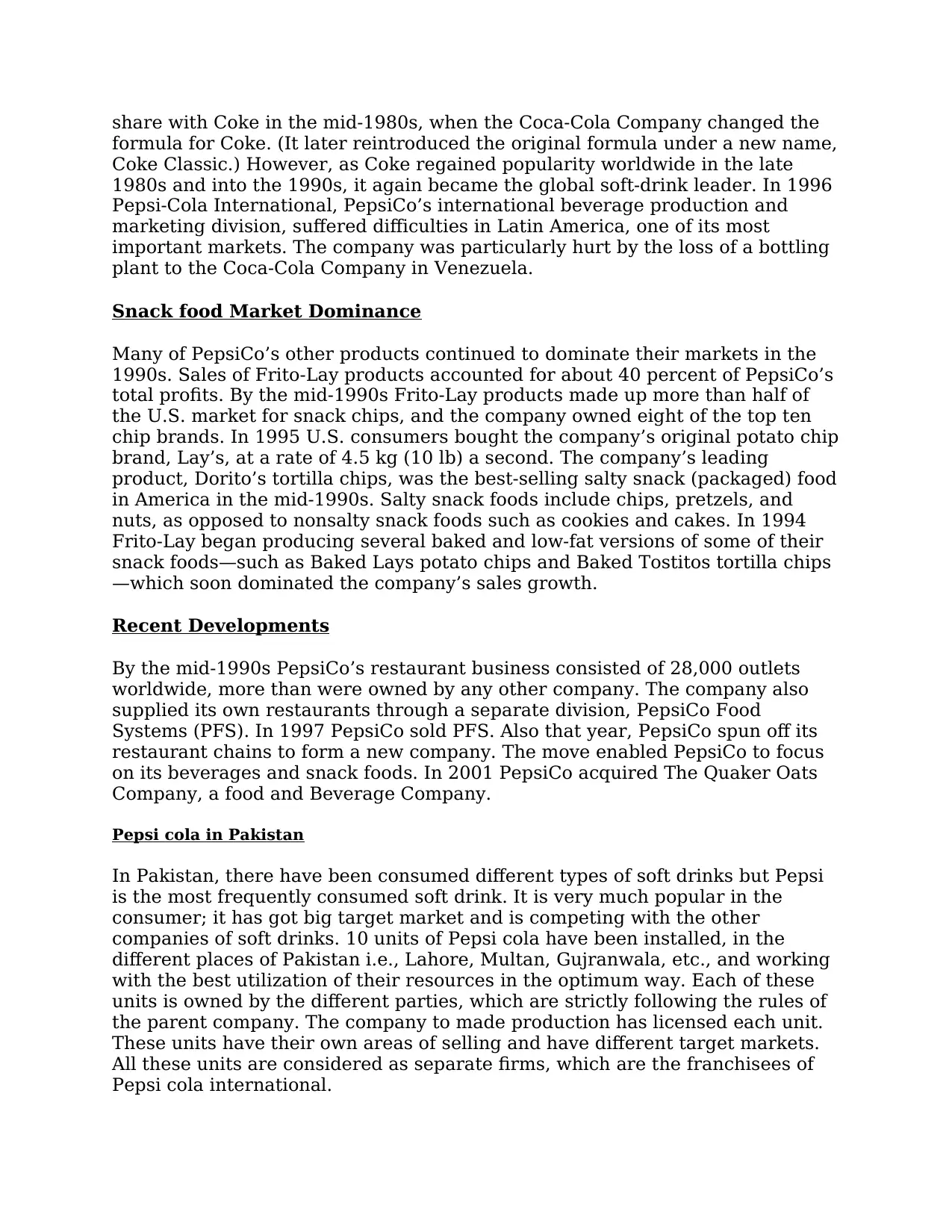
share with Coke in the mid-1980s, when the Coca-Cola Company changed the
formula for Coke. (It later reintroduced the original formula under a new name,
Coke Classic.) However, as Coke regained popularity worldwide in the late
1980s and into the 1990s, it again became the global soft-drink leader. In 1996
Pepsi-Cola International, PepsiCo’s international beverage production and
marketing division, suffered difficulties in Latin America, one of its most
important markets. The company was particularly hurt by the loss of a bottling
plant to the Coca-Cola Company in Venezuela.
Snack food Market Dominance
Many of PepsiCo’s other products continued to dominate their markets in the
1990s. Sales of Frito-Lay products accounted for about 40 percent of PepsiCo’s
total profits. By the mid-1990s Frito-Lay products made up more than half of
the U.S. market for snack chips, and the company owned eight of the top ten
chip brands. In 1995 U.S. consumers bought the company’s original potato chip
brand, Lay’s, at a rate of 4.5 kg (10 lb) a second. The company’s leading
product, Dorito’s tortilla chips, was the best-selling salty snack (packaged) food
in America in the mid-1990s. Salty snack foods include chips, pretzels, and
nuts, as opposed to nonsalty snack foods such as cookies and cakes. In 1994
Frito-Lay began producing several baked and low-fat versions of some of their
snack foods—such as Baked Lays potato chips and Baked Tostitos tortilla chips
—which soon dominated the company’s sales growth.
Recent Developments
By the mid-1990s PepsiCo’s restaurant business consisted of 28,000 outlets
worldwide, more than were owned by any other company. The company also
supplied its own restaurants through a separate division, PepsiCo Food
Systems (PFS). In 1997 PepsiCo sold PFS. Also that year, PepsiCo spun off its
restaurant chains to form a new company. The move enabled PepsiCo to focus
on its beverages and snack foods. In 2001 PepsiCo acquired The Quaker Oats
Company, a food and Beverage Company.
Pepsi cola in Pakistan
In Pakistan, there have been consumed different types of soft drinks but Pepsi
is the most frequently consumed soft drink. It is very much popular in the
consumer; it has got big target market and is competing with the other
companies of soft drinks. 10 units of Pepsi cola have been installed, in the
different places of Pakistan i.e., Lahore, Multan, Gujranwala, etc., and working
with the best utilization of their resources in the optimum way. Each of these
units is owned by the different parties, which are strictly following the rules of
the parent company. The company to made production has licensed each unit.
These units have their own areas of selling and have different target markets.
All these units are considered as separate firms, which are the franchisees of
Pepsi cola international.
formula for Coke. (It later reintroduced the original formula under a new name,
Coke Classic.) However, as Coke regained popularity worldwide in the late
1980s and into the 1990s, it again became the global soft-drink leader. In 1996
Pepsi-Cola International, PepsiCo’s international beverage production and
marketing division, suffered difficulties in Latin America, one of its most
important markets. The company was particularly hurt by the loss of a bottling
plant to the Coca-Cola Company in Venezuela.
Snack food Market Dominance
Many of PepsiCo’s other products continued to dominate their markets in the
1990s. Sales of Frito-Lay products accounted for about 40 percent of PepsiCo’s
total profits. By the mid-1990s Frito-Lay products made up more than half of
the U.S. market for snack chips, and the company owned eight of the top ten
chip brands. In 1995 U.S. consumers bought the company’s original potato chip
brand, Lay’s, at a rate of 4.5 kg (10 lb) a second. The company’s leading
product, Dorito’s tortilla chips, was the best-selling salty snack (packaged) food
in America in the mid-1990s. Salty snack foods include chips, pretzels, and
nuts, as opposed to nonsalty snack foods such as cookies and cakes. In 1994
Frito-Lay began producing several baked and low-fat versions of some of their
snack foods—such as Baked Lays potato chips and Baked Tostitos tortilla chips
—which soon dominated the company’s sales growth.
Recent Developments
By the mid-1990s PepsiCo’s restaurant business consisted of 28,000 outlets
worldwide, more than were owned by any other company. The company also
supplied its own restaurants through a separate division, PepsiCo Food
Systems (PFS). In 1997 PepsiCo sold PFS. Also that year, PepsiCo spun off its
restaurant chains to form a new company. The move enabled PepsiCo to focus
on its beverages and snack foods. In 2001 PepsiCo acquired The Quaker Oats
Company, a food and Beverage Company.
Pepsi cola in Pakistan
In Pakistan, there have been consumed different types of soft drinks but Pepsi
is the most frequently consumed soft drink. It is very much popular in the
consumer; it has got big target market and is competing with the other
companies of soft drinks. 10 units of Pepsi cola have been installed, in the
different places of Pakistan i.e., Lahore, Multan, Gujranwala, etc., and working
with the best utilization of their resources in the optimum way. Each of these
units is owned by the different parties, which are strictly following the rules of
the parent company. The company to made production has licensed each unit.
These units have their own areas of selling and have different target markets.
All these units are considered as separate firms, which are the franchisees of
Pepsi cola international.
⊘ This is a preview!⊘
Do you want full access?
Subscribe today to unlock all pages.

Trusted by 1+ million students worldwide
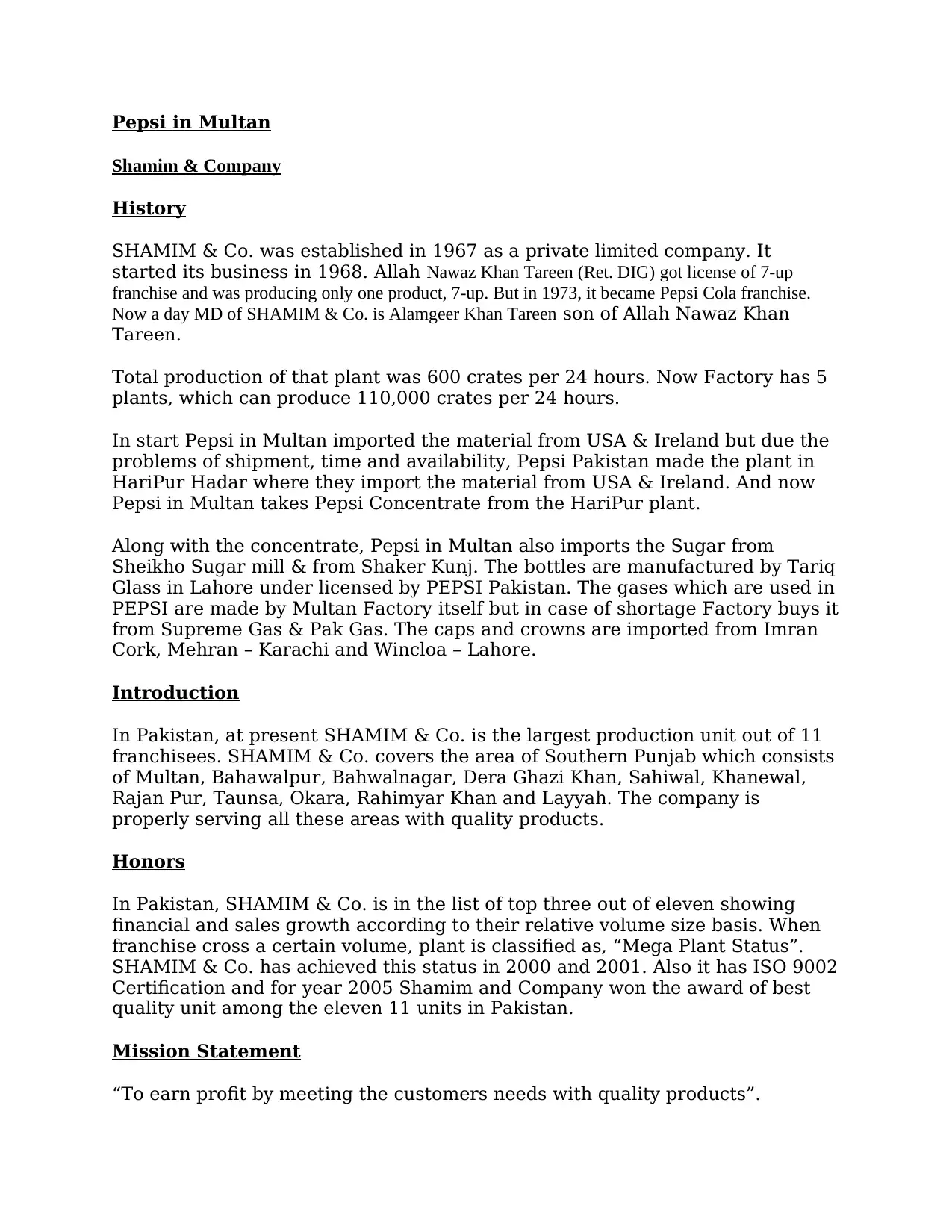
Pepsi in Multan
Shamim & Company
History
SHAMIM & Co. was established in 1967 as a private limited company. It
started its business in 1968. Allah Nawaz Khan Tareen (Ret. DIG) got license of 7-up
franchise and was producing only one product, 7-up. But in 1973, it became Pepsi Cola franchise.
Now a day MD of SHAMIM & Co. is Alamgeer Khan Tareen son of Allah Nawaz Khan
Tareen.
Total production of that plant was 600 crates per 24 hours. Now Factory has 5
plants, which can produce 110,000 crates per 24 hours.
In start Pepsi in Multan imported the material from USA & Ireland but due the
problems of shipment, time and availability, Pepsi Pakistan made the plant in
HariPur Hadar where they import the material from USA & Ireland. And now
Pepsi in Multan takes Pepsi Concentrate from the HariPur plant.
Along with the concentrate, Pepsi in Multan also imports the Sugar from
Sheikho Sugar mill & from Shaker Kunj. The bottles are manufactured by Tariq
Glass in Lahore under licensed by PEPSI Pakistan. The gases which are used in
PEPSI are made by Multan Factory itself but in case of shortage Factory buys it
from Supreme Gas & Pak Gas. The caps and crowns are imported from Imran
Cork, Mehran – Karachi and Wincloa – Lahore.
Introduction
In Pakistan, at present SHAMIM & Co. is the largest production unit out of 11
franchisees. SHAMIM & Co. covers the area of Southern Punjab which consists
of Multan, Bahawalpur, Bahwalnagar, Dera Ghazi Khan, Sahiwal, Khanewal,
Rajan Pur, Taunsa, Okara, Rahimyar Khan and Layyah. The company is
properly serving all these areas with quality products.
Honors
In Pakistan, SHAMIM & Co. is in the list of top three out of eleven showing
financial and sales growth according to their relative volume size basis. When
franchise cross a certain volume, plant is classified as, “Mega Plant Status”.
SHAMIM & Co. has achieved this status in 2000 and 2001. Also it has ISO 9002
Certification and for year 2005 Shamim and Company won the award of best
quality unit among the eleven 11 units in Pakistan.
Mission Statement
“To earn profit by meeting the customers needs with quality products”.
Shamim & Company
History
SHAMIM & Co. was established in 1967 as a private limited company. It
started its business in 1968. Allah Nawaz Khan Tareen (Ret. DIG) got license of 7-up
franchise and was producing only one product, 7-up. But in 1973, it became Pepsi Cola franchise.
Now a day MD of SHAMIM & Co. is Alamgeer Khan Tareen son of Allah Nawaz Khan
Tareen.
Total production of that plant was 600 crates per 24 hours. Now Factory has 5
plants, which can produce 110,000 crates per 24 hours.
In start Pepsi in Multan imported the material from USA & Ireland but due the
problems of shipment, time and availability, Pepsi Pakistan made the plant in
HariPur Hadar where they import the material from USA & Ireland. And now
Pepsi in Multan takes Pepsi Concentrate from the HariPur plant.
Along with the concentrate, Pepsi in Multan also imports the Sugar from
Sheikho Sugar mill & from Shaker Kunj. The bottles are manufactured by Tariq
Glass in Lahore under licensed by PEPSI Pakistan. The gases which are used in
PEPSI are made by Multan Factory itself but in case of shortage Factory buys it
from Supreme Gas & Pak Gas. The caps and crowns are imported from Imran
Cork, Mehran – Karachi and Wincloa – Lahore.
Introduction
In Pakistan, at present SHAMIM & Co. is the largest production unit out of 11
franchisees. SHAMIM & Co. covers the area of Southern Punjab which consists
of Multan, Bahawalpur, Bahwalnagar, Dera Ghazi Khan, Sahiwal, Khanewal,
Rajan Pur, Taunsa, Okara, Rahimyar Khan and Layyah. The company is
properly serving all these areas with quality products.
Honors
In Pakistan, SHAMIM & Co. is in the list of top three out of eleven showing
financial and sales growth according to their relative volume size basis. When
franchise cross a certain volume, plant is classified as, “Mega Plant Status”.
SHAMIM & Co. has achieved this status in 2000 and 2001. Also it has ISO 9002
Certification and for year 2005 Shamim and Company won the award of best
quality unit among the eleven 11 units in Pakistan.
Mission Statement
“To earn profit by meeting the customers needs with quality products”.
Paraphrase This Document
Need a fresh take? Get an instant paraphrase of this document with our AI Paraphraser
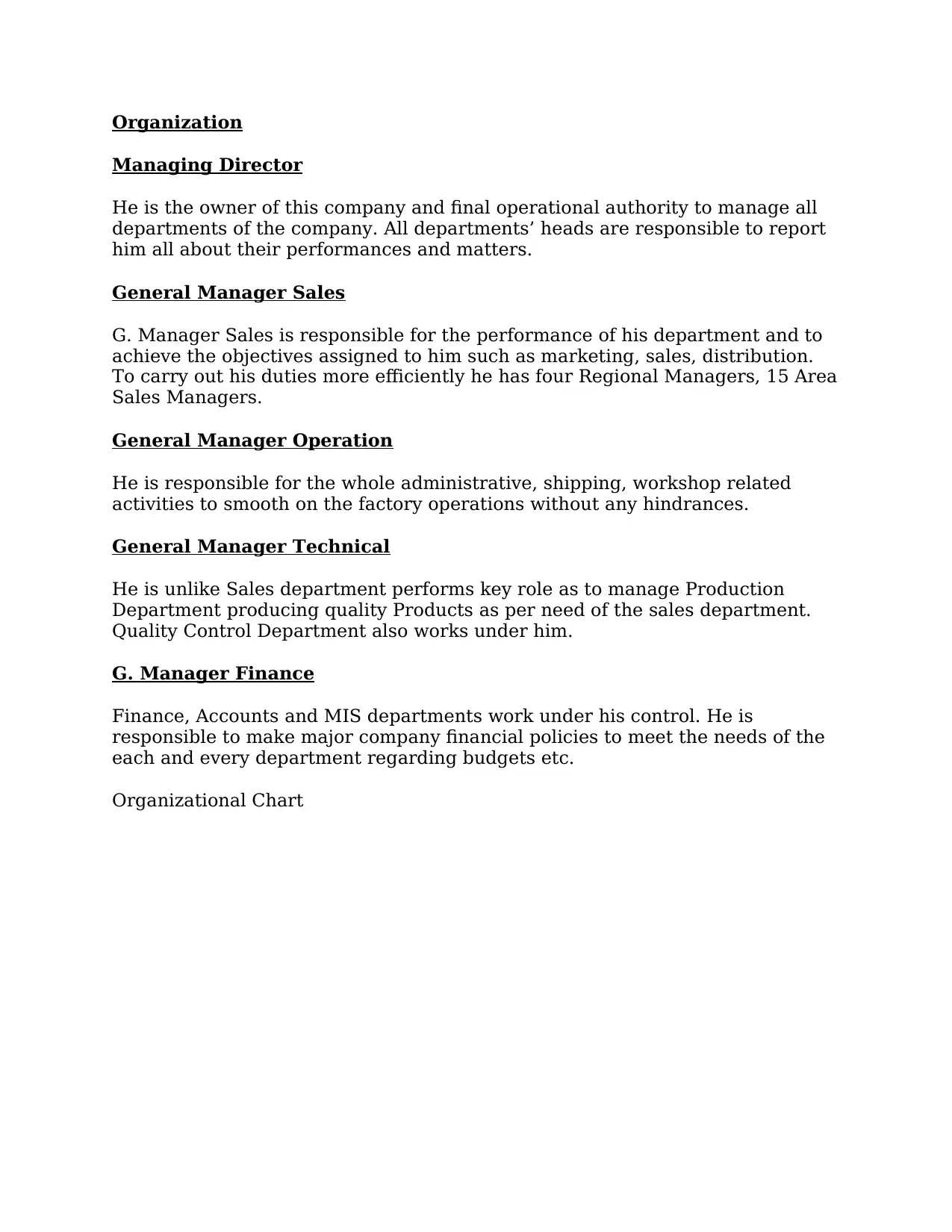
Organization
Managing Director
He is the owner of this company and final operational authority to manage all
departments of the company. All departments’ heads are responsible to report
him all about their performances and matters.
General Manager Sales
G. Manager Sales is responsible for the performance of his department and to
achieve the objectives assigned to him such as marketing, sales, distribution.
To carry out his duties more efficiently he has four Regional Managers, 15 Area
Sales Managers.
General Manager Operation
He is responsible for the whole administrative, shipping, workshop related
activities to smooth on the factory operations without any hindrances.
General Manager Technical
He is unlike Sales department performs key role as to manage Production
Department producing quality Products as per need of the sales department.
Quality Control Department also works under him.
G. Manager Finance
Finance, Accounts and MIS departments work under his control. He is
responsible to make major company financial policies to meet the needs of the
each and every department regarding budgets etc.
Organizational Chart
Managing Director
He is the owner of this company and final operational authority to manage all
departments of the company. All departments’ heads are responsible to report
him all about their performances and matters.
General Manager Sales
G. Manager Sales is responsible for the performance of his department and to
achieve the objectives assigned to him such as marketing, sales, distribution.
To carry out his duties more efficiently he has four Regional Managers, 15 Area
Sales Managers.
General Manager Operation
He is responsible for the whole administrative, shipping, workshop related
activities to smooth on the factory operations without any hindrances.
General Manager Technical
He is unlike Sales department performs key role as to manage Production
Department producing quality Products as per need of the sales department.
Quality Control Department also works under him.
G. Manager Finance
Finance, Accounts and MIS departments work under his control. He is
responsible to make major company financial policies to meet the needs of the
each and every department regarding budgets etc.
Organizational Chart
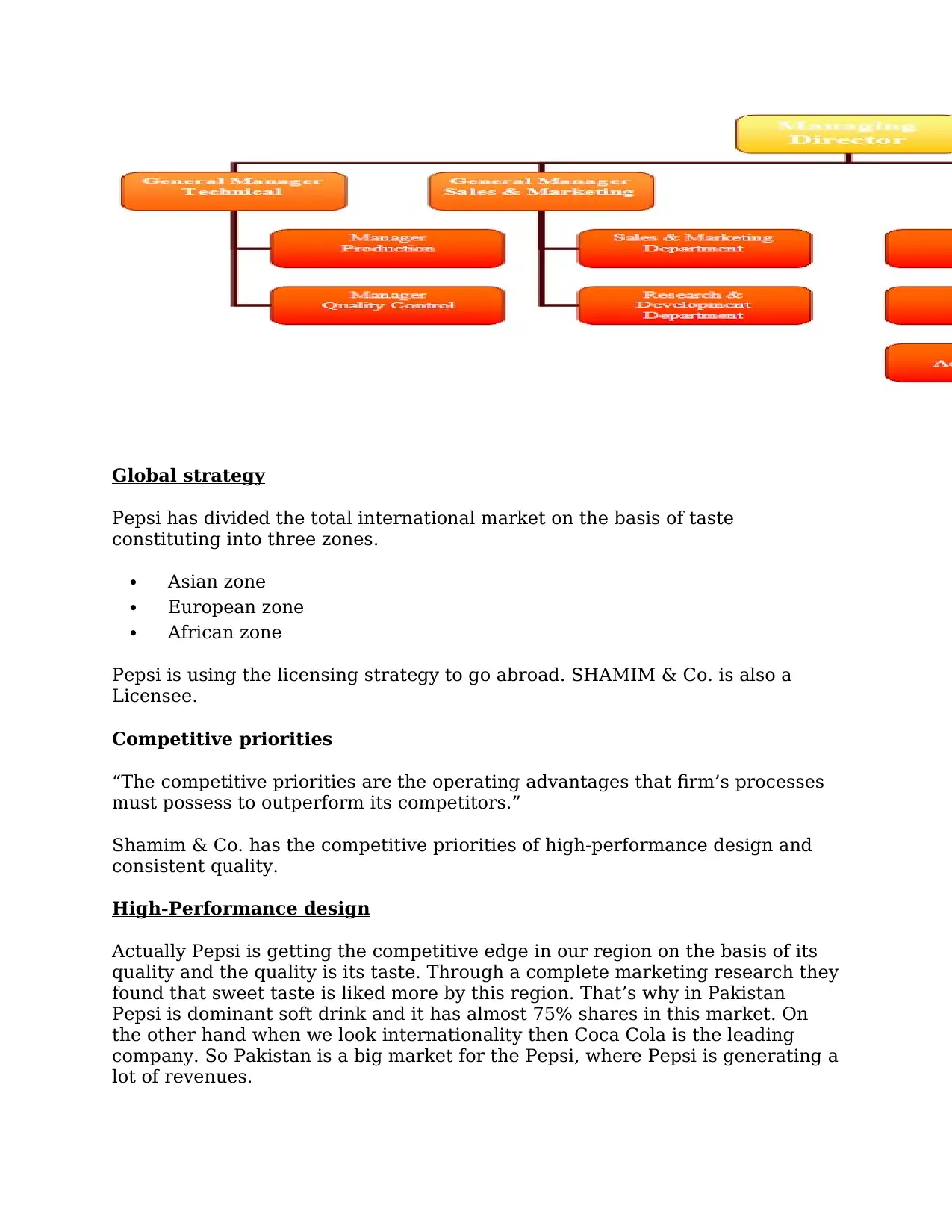
Global strategy
Pepsi has divided the total international market on the basis of taste
constituting into three zones.
Asian zone
European zone
African zone
Pepsi is using the licensing strategy to go abroad. SHAMIM & Co. is also a
Licensee.
Competitive priorities
“The competitive priorities are the operating advantages that firm’s processes
must possess to outperform its competitors.”
Shamim & Co. has the competitive priorities of high-performance design and
consistent quality.
High-Performance design
Actually Pepsi is getting the competitive edge in our region on the basis of its
quality and the quality is its taste. Through a complete marketing research they
found that sweet taste is liked more by this region. That’s why in Pakistan
Pepsi is dominant soft drink and it has almost 75% shares in this market. On
the other hand when we look internationality then Coca Cola is the leading
company. So Pakistan is a big market for the Pepsi, where Pepsi is generating a
lot of revenues.
Pepsi has divided the total international market on the basis of taste
constituting into three zones.
Asian zone
European zone
African zone
Pepsi is using the licensing strategy to go abroad. SHAMIM & Co. is also a
Licensee.
Competitive priorities
“The competitive priorities are the operating advantages that firm’s processes
must possess to outperform its competitors.”
Shamim & Co. has the competitive priorities of high-performance design and
consistent quality.
High-Performance design
Actually Pepsi is getting the competitive edge in our region on the basis of its
quality and the quality is its taste. Through a complete marketing research they
found that sweet taste is liked more by this region. That’s why in Pakistan
Pepsi is dominant soft drink and it has almost 75% shares in this market. On
the other hand when we look internationality then Coca Cola is the leading
company. So Pakistan is a big market for the Pepsi, where Pepsi is generating a
lot of revenues.
⊘ This is a preview!⊘
Do you want full access?
Subscribe today to unlock all pages.

Trusted by 1+ million students worldwide
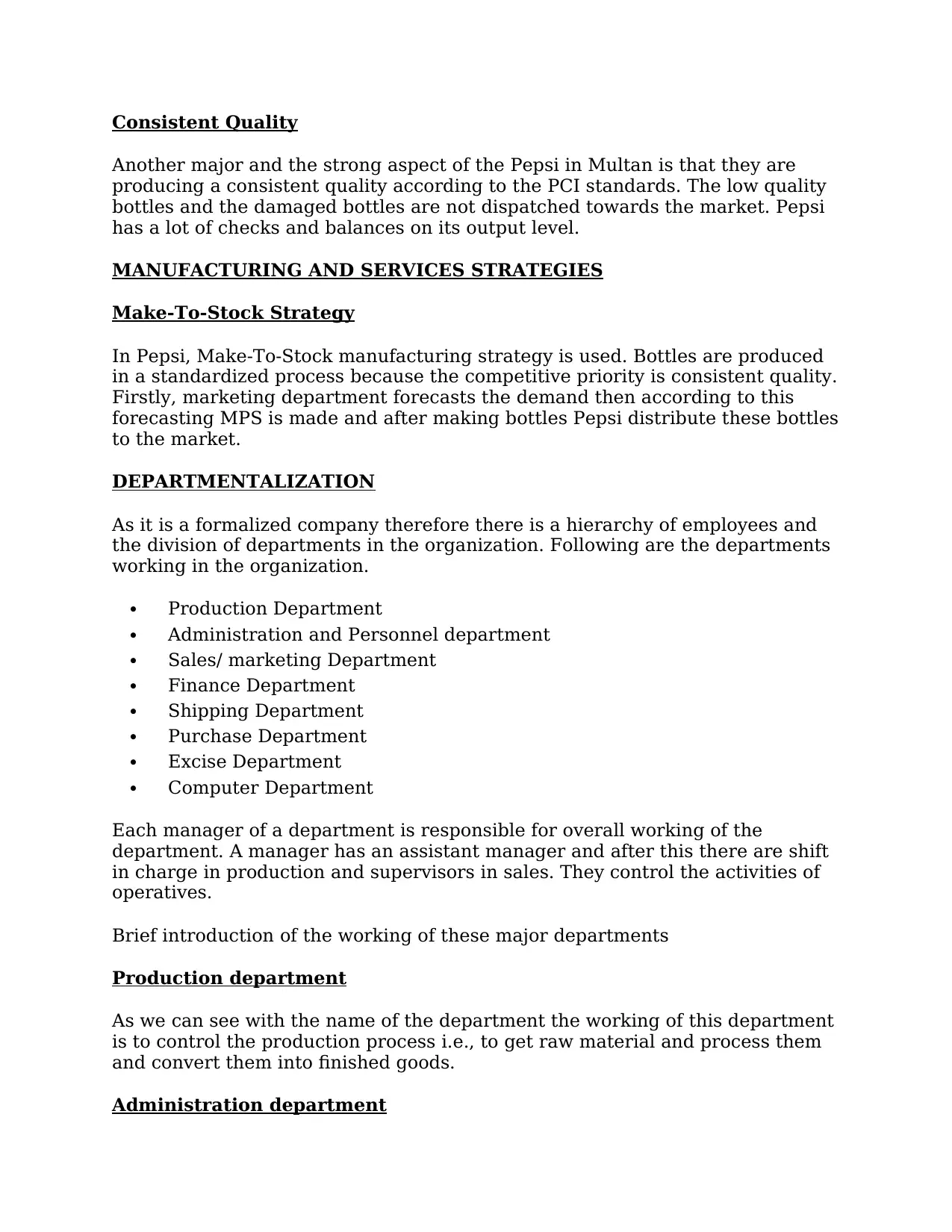
Consistent Quality
Another major and the strong aspect of the Pepsi in Multan is that they are
producing a consistent quality according to the PCI standards. The low quality
bottles and the damaged bottles are not dispatched towards the market. Pepsi
has a lot of checks and balances on its output level.
MANUFACTURING AND SERVICES STRATEGIES
Make-To-Stock Strategy
In Pepsi, Make-To-Stock manufacturing strategy is used. Bottles are produced
in a standardized process because the competitive priority is consistent quality.
Firstly, marketing department forecasts the demand then according to this
forecasting MPS is made and after making bottles Pepsi distribute these bottles
to the market.
DEPARTMENTALIZATION
As it is a formalized company therefore there is a hierarchy of employees and
the division of departments in the organization. Following are the departments
working in the organization.
Production Department
Administration and Personnel department
Sales/ marketing Department
Finance Department
Shipping Department
Purchase Department
Excise Department
Computer Department
Each manager of a department is responsible for overall working of the
department. A manager has an assistant manager and after this there are shift
in charge in production and supervisors in sales. They control the activities of
operatives.
Brief introduction of the working of these major departments
Production department
As we can see with the name of the department the working of this department
is to control the production process i.e., to get raw material and process them
and convert them into finished goods.
Administration department
Another major and the strong aspect of the Pepsi in Multan is that they are
producing a consistent quality according to the PCI standards. The low quality
bottles and the damaged bottles are not dispatched towards the market. Pepsi
has a lot of checks and balances on its output level.
MANUFACTURING AND SERVICES STRATEGIES
Make-To-Stock Strategy
In Pepsi, Make-To-Stock manufacturing strategy is used. Bottles are produced
in a standardized process because the competitive priority is consistent quality.
Firstly, marketing department forecasts the demand then according to this
forecasting MPS is made and after making bottles Pepsi distribute these bottles
to the market.
DEPARTMENTALIZATION
As it is a formalized company therefore there is a hierarchy of employees and
the division of departments in the organization. Following are the departments
working in the organization.
Production Department
Administration and Personnel department
Sales/ marketing Department
Finance Department
Shipping Department
Purchase Department
Excise Department
Computer Department
Each manager of a department is responsible for overall working of the
department. A manager has an assistant manager and after this there are shift
in charge in production and supervisors in sales. They control the activities of
operatives.
Brief introduction of the working of these major departments
Production department
As we can see with the name of the department the working of this department
is to control the production process i.e., to get raw material and process them
and convert them into finished goods.
Administration department
Paraphrase This Document
Need a fresh take? Get an instant paraphrase of this document with our AI Paraphraser
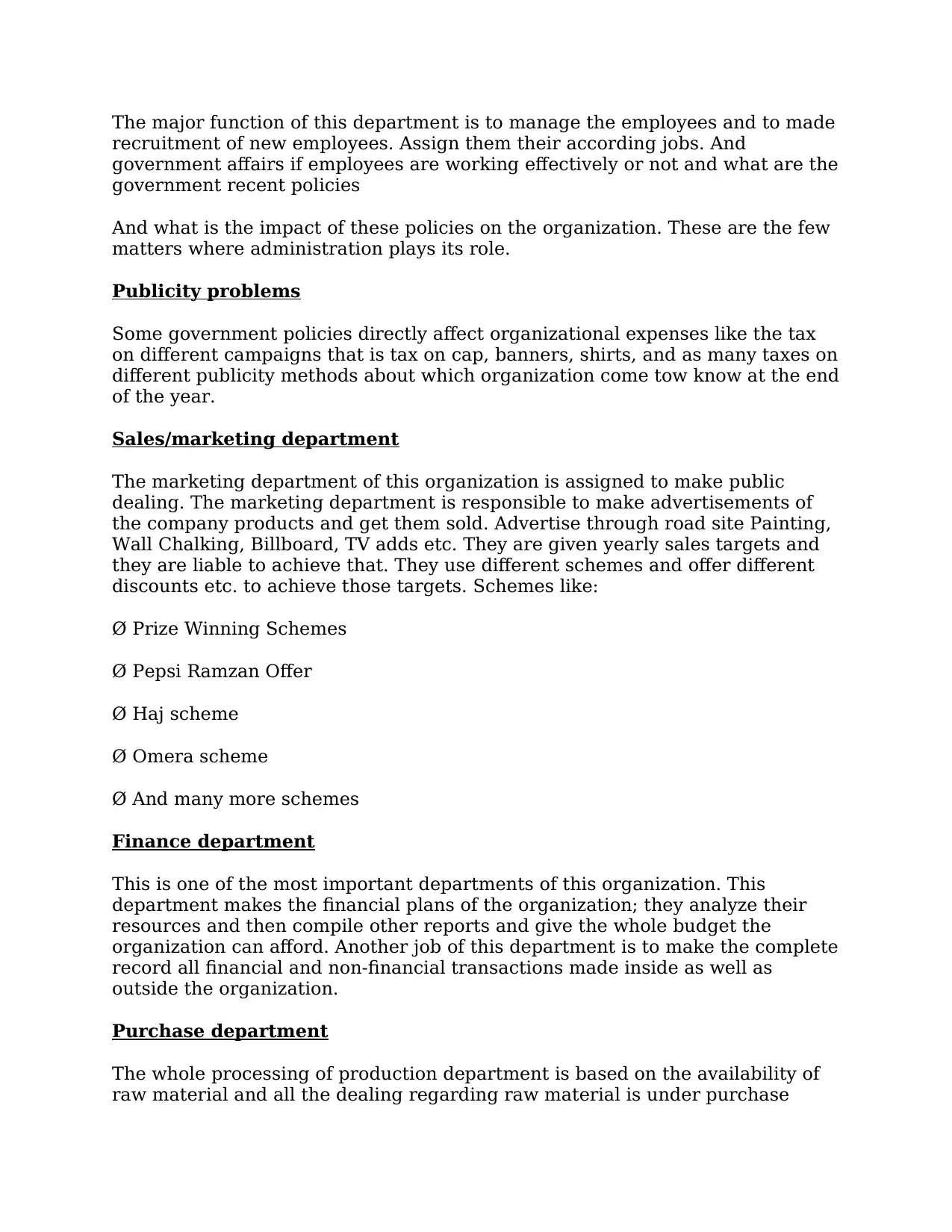
The major function of this department is to manage the employees and to made
recruitment of new employees. Assign them their according jobs. And
government affairs if employees are working effectively or not and what are the
government recent policies
And what is the impact of these policies on the organization. These are the few
matters where administration plays its role.
Publicity problems
Some government policies directly affect organizational expenses like the tax
on different campaigns that is tax on cap, banners, shirts, and as many taxes on
different publicity methods about which organization come tow know at the end
of the year.
Sales/marketing department
The marketing department of this organization is assigned to make public
dealing. The marketing department is responsible to make advertisements of
the company products and get them sold. Advertise through road site Painting,
Wall Chalking, Billboard, TV adds etc. They are given yearly sales targets and
they are liable to achieve that. They use different schemes and offer different
discounts etc. to achieve those targets. Schemes like:
Ø Prize Winning Schemes
Ø Pepsi Ramzan Offer
Ø Haj scheme
Ø Omera scheme
Ø And many more schemes
Finance department
This is one of the most important departments of this organization. This
department makes the financial plans of the organization; they analyze their
resources and then compile other reports and give the whole budget the
organization can afford. Another job of this department is to make the complete
record all financial and non-financial transactions made inside as well as
outside the organization.
Purchase department
The whole processing of production department is based on the availability of
raw material and all the dealing regarding raw material is under purchase
recruitment of new employees. Assign them their according jobs. And
government affairs if employees are working effectively or not and what are the
government recent policies
And what is the impact of these policies on the organization. These are the few
matters where administration plays its role.
Publicity problems
Some government policies directly affect organizational expenses like the tax
on different campaigns that is tax on cap, banners, shirts, and as many taxes on
different publicity methods about which organization come tow know at the end
of the year.
Sales/marketing department
The marketing department of this organization is assigned to make public
dealing. The marketing department is responsible to make advertisements of
the company products and get them sold. Advertise through road site Painting,
Wall Chalking, Billboard, TV adds etc. They are given yearly sales targets and
they are liable to achieve that. They use different schemes and offer different
discounts etc. to achieve those targets. Schemes like:
Ø Prize Winning Schemes
Ø Pepsi Ramzan Offer
Ø Haj scheme
Ø Omera scheme
Ø And many more schemes
Finance department
This is one of the most important departments of this organization. This
department makes the financial plans of the organization; they analyze their
resources and then compile other reports and give the whole budget the
organization can afford. Another job of this department is to make the complete
record all financial and non-financial transactions made inside as well as
outside the organization.
Purchase department
The whole processing of production department is based on the availability of
raw material and all the dealing regarding raw material is under purchase
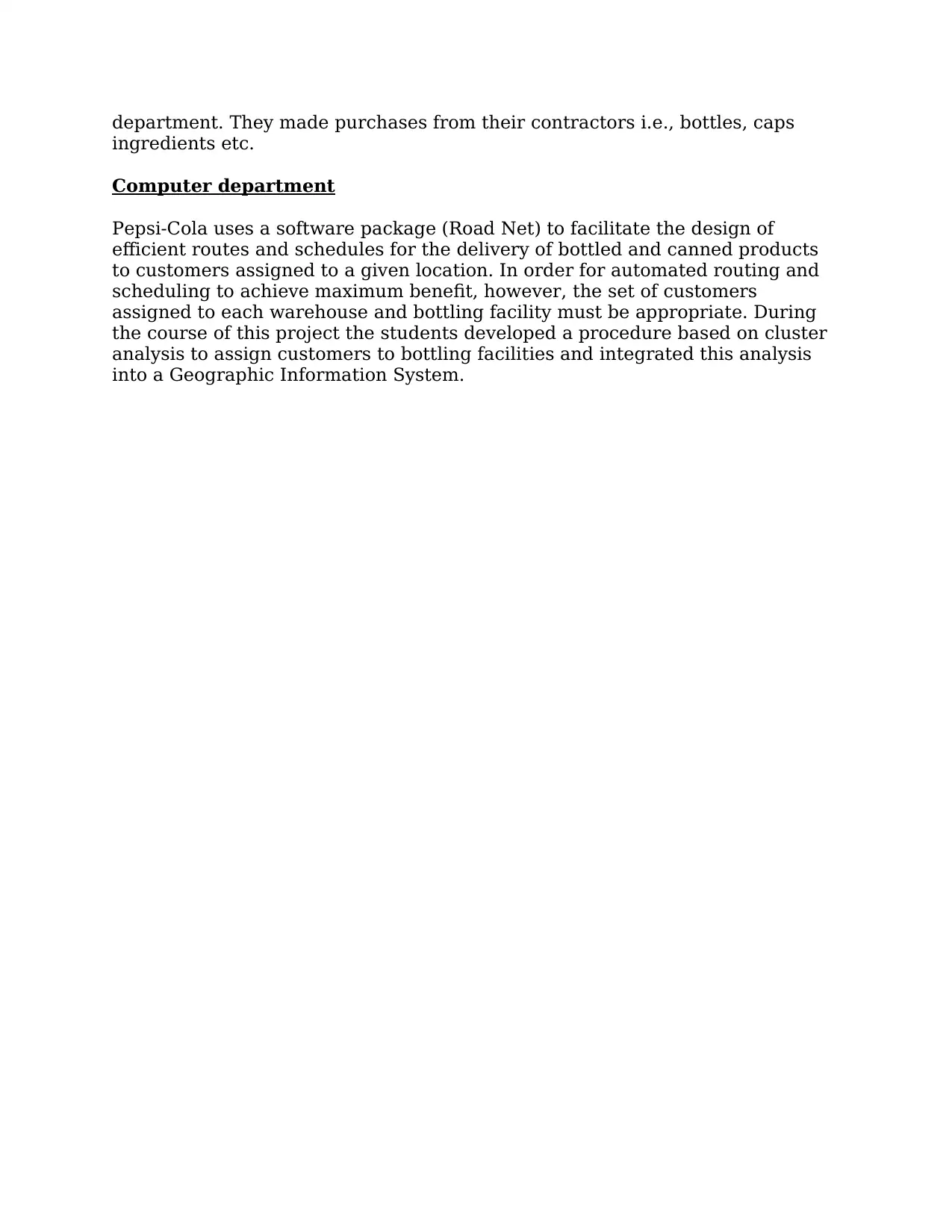
department. They made purchases from their contractors i.e., bottles, caps
ingredients etc.
Computer department
Pepsi-Cola uses a software package (Road Net) to facilitate the design of
efficient routes and schedules for the delivery of bottled and canned products
to customers assigned to a given location. In order for automated routing and
scheduling to achieve maximum benefit, however, the set of customers
assigned to each warehouse and bottling facility must be appropriate. During
the course of this project the students developed a procedure based on cluster
analysis to assign customers to bottling facilities and integrated this analysis
into a Geographic Information System.
ingredients etc.
Computer department
Pepsi-Cola uses a software package (Road Net) to facilitate the design of
efficient routes and schedules for the delivery of bottled and canned products
to customers assigned to a given location. In order for automated routing and
scheduling to achieve maximum benefit, however, the set of customers
assigned to each warehouse and bottling facility must be appropriate. During
the course of this project the students developed a procedure based on cluster
analysis to assign customers to bottling facilities and integrated this analysis
into a Geographic Information System.
⊘ This is a preview!⊘
Do you want full access?
Subscribe today to unlock all pages.

Trusted by 1+ million students worldwide
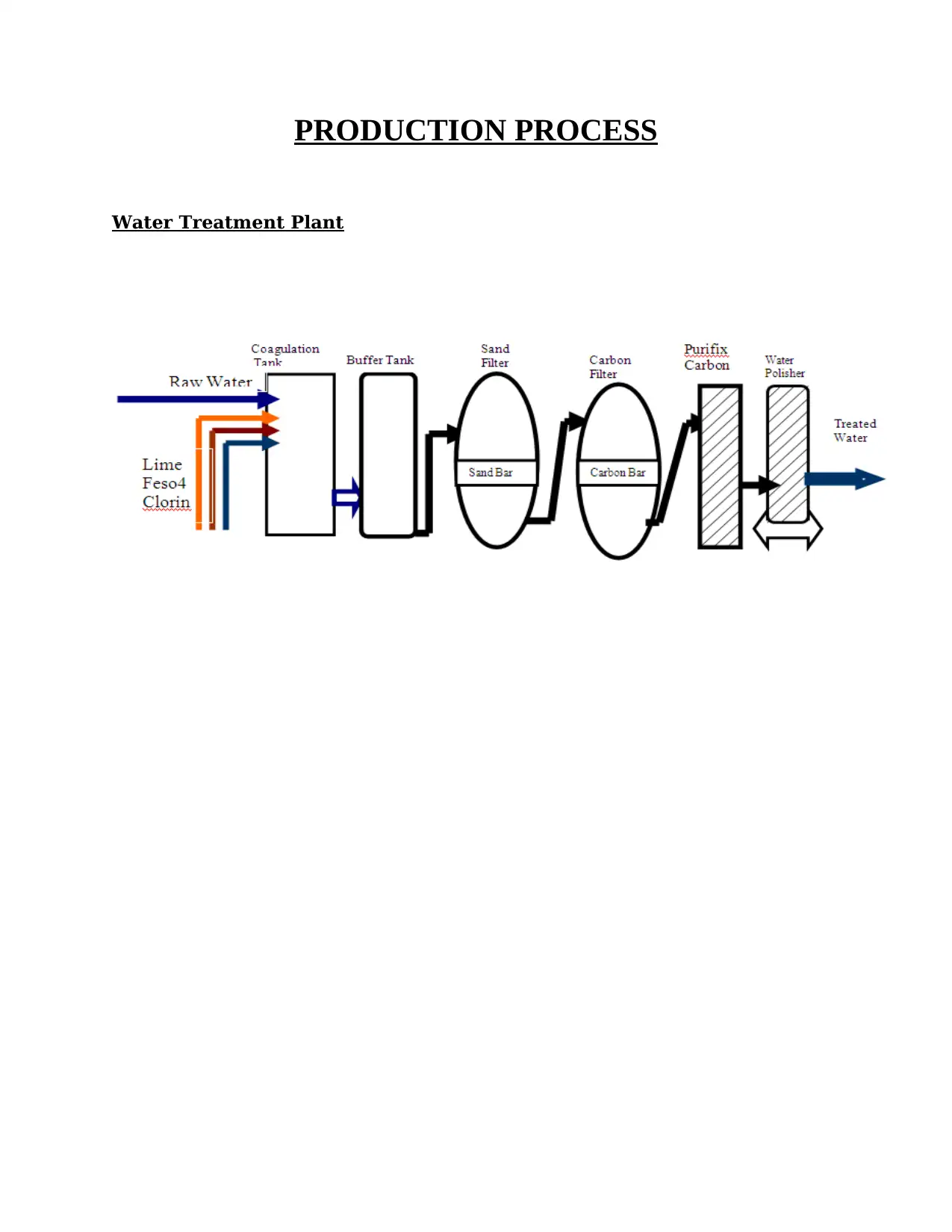
PRODUCTION PROCESS
Water Treatment Plant
Water Treatment Plant
Paraphrase This Document
Need a fresh take? Get an instant paraphrase of this document with our AI Paraphraser
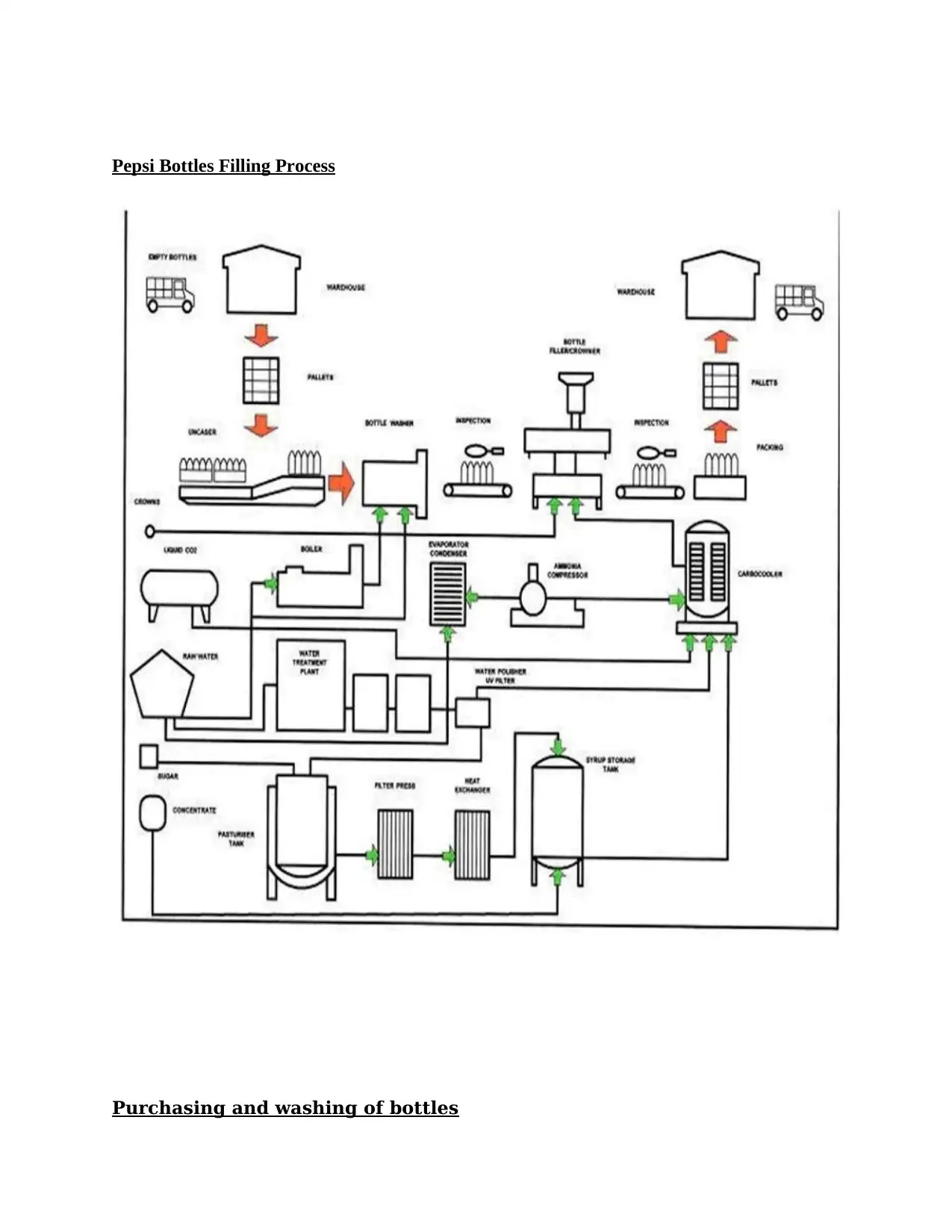
Pepsi Bottles Filling Process
Purchasing and washing of bottles
Purchasing and washing of bottles
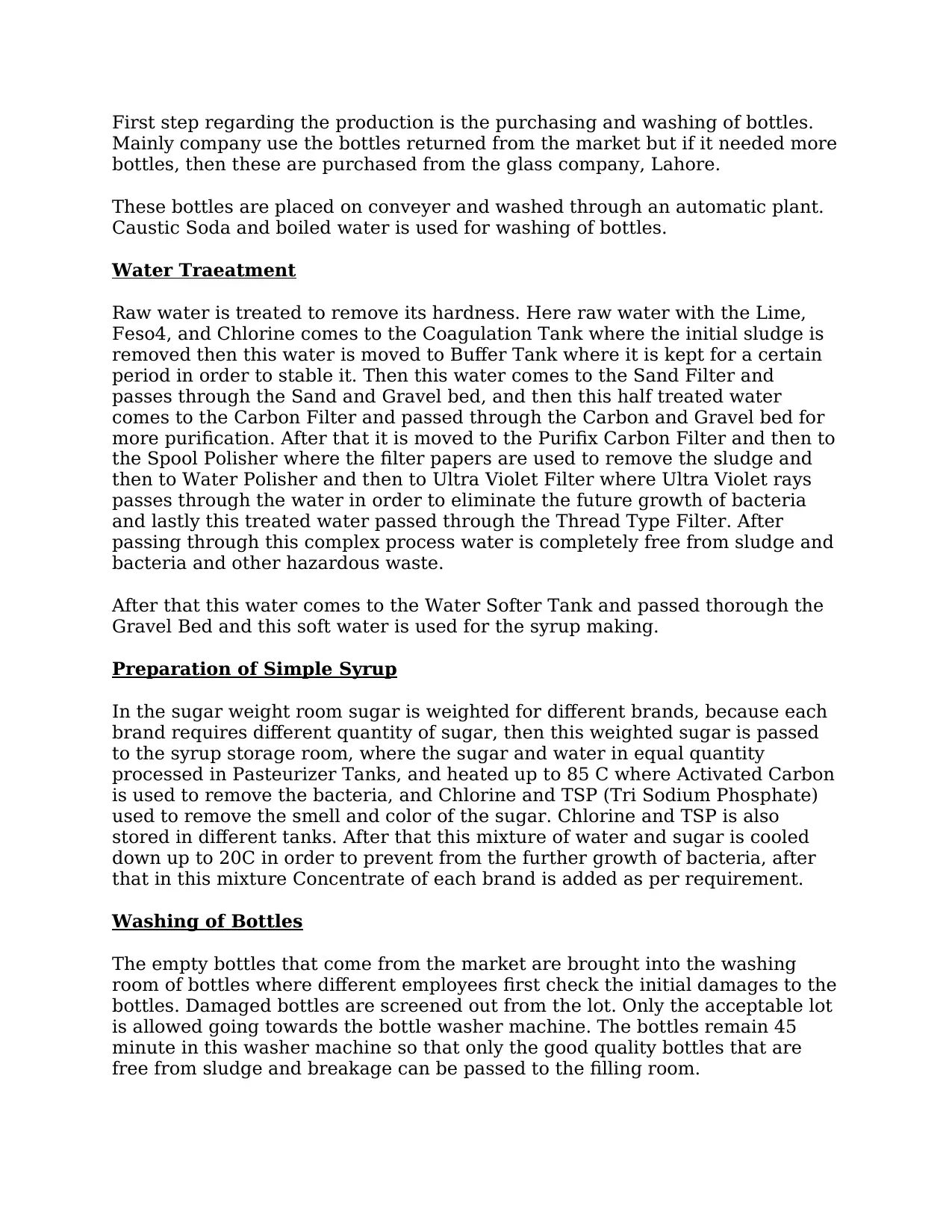
First step regarding the production is the purchasing and washing of bottles.
Mainly company use the bottles returned from the market but if it needed more
bottles, then these are purchased from the glass company, Lahore.
These bottles are placed on conveyer and washed through an automatic plant.
Caustic Soda and boiled water is used for washing of bottles.
Water Traeatment
Raw water is treated to remove its hardness. Here raw water with the Lime,
Feso4, and Chlorine comes to the Coagulation Tank where the initial sludge is
removed then this water is moved to Buffer Tank where it is kept for a certain
period in order to stable it. Then this water comes to the Sand Filter and
passes through the Sand and Gravel bed, and then this half treated water
comes to the Carbon Filter and passed through the Carbon and Gravel bed for
more purification. After that it is moved to the Purifix Carbon Filter and then to
the Spool Polisher where the filter papers are used to remove the sludge and
then to Water Polisher and then to Ultra Violet Filter where Ultra Violet rays
passes through the water in order to eliminate the future growth of bacteria
and lastly this treated water passed through the Thread Type Filter. After
passing through this complex process water is completely free from sludge and
bacteria and other hazardous waste.
After that this water comes to the Water Softer Tank and passed thorough the
Gravel Bed and this soft water is used for the syrup making.
Preparation of Simple Syrup
In the sugar weight room sugar is weighted for different brands, because each
brand requires different quantity of sugar, then this weighted sugar is passed
to the syrup storage room, where the sugar and water in equal quantity
processed in Pasteurizer Tanks, and heated up to 85 C where Activated Carbon
is used to remove the bacteria, and Chlorine and TSP (Tri Sodium Phosphate)
used to remove the smell and color of the sugar. Chlorine and TSP is also
stored in different tanks. After that this mixture of water and sugar is cooled
down up to 20C in order to prevent from the further growth of bacteria, after
that in this mixture Concentrate of each brand is added as per requirement.
Washing of Bottles
The empty bottles that come from the market are brought into the washing
room of bottles where different employees first check the initial damages to the
bottles. Damaged bottles are screened out from the lot. Only the acceptable lot
is allowed going towards the bottle washer machine. The bottles remain 45
minute in this washer machine so that only the good quality bottles that are
free from sludge and breakage can be passed to the filling room.
Mainly company use the bottles returned from the market but if it needed more
bottles, then these are purchased from the glass company, Lahore.
These bottles are placed on conveyer and washed through an automatic plant.
Caustic Soda and boiled water is used for washing of bottles.
Water Traeatment
Raw water is treated to remove its hardness. Here raw water with the Lime,
Feso4, and Chlorine comes to the Coagulation Tank where the initial sludge is
removed then this water is moved to Buffer Tank where it is kept for a certain
period in order to stable it. Then this water comes to the Sand Filter and
passes through the Sand and Gravel bed, and then this half treated water
comes to the Carbon Filter and passed through the Carbon and Gravel bed for
more purification. After that it is moved to the Purifix Carbon Filter and then to
the Spool Polisher where the filter papers are used to remove the sludge and
then to Water Polisher and then to Ultra Violet Filter where Ultra Violet rays
passes through the water in order to eliminate the future growth of bacteria
and lastly this treated water passed through the Thread Type Filter. After
passing through this complex process water is completely free from sludge and
bacteria and other hazardous waste.
After that this water comes to the Water Softer Tank and passed thorough the
Gravel Bed and this soft water is used for the syrup making.
Preparation of Simple Syrup
In the sugar weight room sugar is weighted for different brands, because each
brand requires different quantity of sugar, then this weighted sugar is passed
to the syrup storage room, where the sugar and water in equal quantity
processed in Pasteurizer Tanks, and heated up to 85 C where Activated Carbon
is used to remove the bacteria, and Chlorine and TSP (Tri Sodium Phosphate)
used to remove the smell and color of the sugar. Chlorine and TSP is also
stored in different tanks. After that this mixture of water and sugar is cooled
down up to 20C in order to prevent from the further growth of bacteria, after
that in this mixture Concentrate of each brand is added as per requirement.
Washing of Bottles
The empty bottles that come from the market are brought into the washing
room of bottles where different employees first check the initial damages to the
bottles. Damaged bottles are screened out from the lot. Only the acceptable lot
is allowed going towards the bottle washer machine. The bottles remain 45
minute in this washer machine so that only the good quality bottles that are
free from sludge and breakage can be passed to the filling room.
⊘ This is a preview!⊘
Do you want full access?
Subscribe today to unlock all pages.

Trusted by 1+ million students worldwide
1 out of 22
Related Documents
Your All-in-One AI-Powered Toolkit for Academic Success.
+13062052269
info@desklib.com
Available 24*7 on WhatsApp / Email
![[object Object]](/_next/static/media/star-bottom.7253800d.svg)
Unlock your academic potential
Copyright © 2020–2025 A2Z Services. All Rights Reserved. Developed and managed by ZUCOL.




